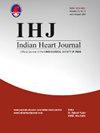Incidence and determinants of left ventricular ejection fraction (LVEF) recovery in heart failure with reduced ejection fraction (HFrEF) of non-ischemic aetiology; a hospital-based prospective longitudinal registry study
IF 1.8
Q3 CARDIAC & CARDIOVASCULAR SYSTEMS
引用次数: 0
Abstract
Background
Heart failure with reduced ejection fraction (HFrEF) can show recovery in some patients, especially with non-ischemic causes, leading to better outcomes. Recovery varies due to factors like aetiology and severity of myocardial injury. This study examines the incidence and predictors of left ventricular ejection fraction (LVEF) recovery in non-ischemic HFrEF patients.
Methods
This was a prospective observational study conducted at a tertiary care hospital, involving 500 patients with non-ischemic HFrEF (baseline LVEF <40 %). Patients were followed for a duration of 8 years (2011–2023) with periodic clinical assessments and annual echocardiographic evaluations. Data on comorbidities, baseline cardiac function, medication adherence, and clinical events were collected. The incidence rate of LVEF recovery was determined, and Kaplan–Meier survival analysis was used to identify recovery trends over time. Predictors of recovery were evaluated using Cox proportional hazards models.
Results
Cumulative incidence of LVEF recovery was 27.4 % (95 % CI: 23.7–31.5) at 8 years, with an incidence rate of 4.5 per 100 person-years. Higher baseline LVEF (≥30 %) strongly predicted recovery (HR: 2.17, p < 0.001), while dilated LV (LVEDD ≥60 mm, HR: 0.6, p = 0.02) and diabetes (HR: 0.36, p = 0.01) were associated with lower recovery. Education (≥Class 5) was linked to better recovery (HR: 1.45, p = 0.04). Beta-blockers showed a potential but nonsignificant benefit.
Conclusion
Nearly one-fourth (27.4 %) of patients achieved LVEF recovery over 8 years, with higher baseline LVEF and education associated with better outcomes, while adverse cardiac remodeling and diabetes were linked to lower recovery.
一项基于医院的前瞻性纵向登记研究:非缺血性病因的射血分数降低型心力衰竭(HFrEF)患者左室射血分数(LVEF)恢复的发生率和决定因素。
背景:心力衰竭伴射血分数降低(HFrEF)可以在一些患者中恢复,特别是非缺血性原因的患者,导致更好的结果。恢复因病因和心肌损伤严重程度等因素而异。本研究探讨了非缺血性HFrEF患者左室射血分数(LVEF)恢复的发生率和预测因素。方法:这是一项在三级医院进行的前瞻性观察性研究,涉及500例非缺血性HFrEF(基线LVEF)患者。结果:8年LVEF恢复的累积发生率为27.4% (95% CI: 23.7-31.5),发病率为每100人年4.5例。结论:近四分之一(27.4%)的患者在8年内实现了LVEF恢复,较高的基线LVEF和教育与较好的结果相关,而不良的心脏重构和糖尿病与较低的恢复相关。
本文章由计算机程序翻译,如有差异,请以英文原文为准。
求助全文
约1分钟内获得全文
求助全文
来源期刊

Indian heart journal
CARDIAC & CARDIOVASCULAR SYSTEMS-
CiteScore
2.60
自引率
6.70%
发文量
82
审稿时长
52 days
期刊介绍:
Indian Heart Journal (IHJ) is the official peer-reviewed open access journal of Cardiological Society of India and accepts articles for publication from across the globe. The journal aims to promote high quality research and serve as a platform for dissemination of scientific information in cardiology with particular focus on South Asia. The journal aims to publish cutting edge research in the field of clinical as well as non-clinical cardiology - including cardiovascular medicine and surgery. Some of the topics covered are Heart Failure, Coronary Artery Disease, Hypertension, Interventional Cardiology, Cardiac Surgery, Valvular Heart Disease, Pulmonary Hypertension and Infective Endocarditis. IHJ open access invites original research articles, research briefs, perspective, case reports, case vignette, cardiovascular images, cardiovascular graphics, research letters, correspondence, reader forum, and interesting photographs, for publication. IHJ open access also publishes theme-based special issues and abstracts of papers presented at the annual conference of the Cardiological Society of India.
 求助内容:
求助内容: 应助结果提醒方式:
应助结果提醒方式:


